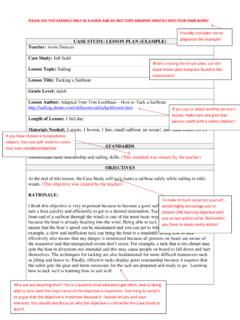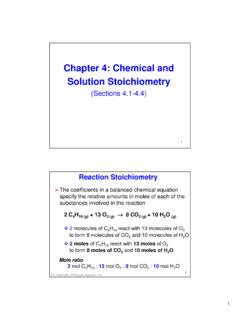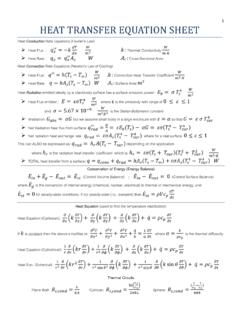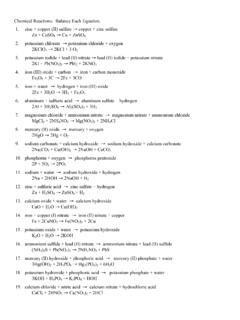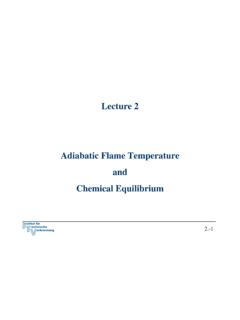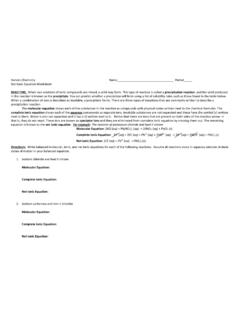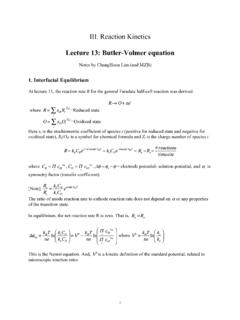Transcription of Calculations from chemical equations Mole - mole …
1 Calculations from chemical equationsIf you know the amount of any reactant or product involved in the reaction: you can calculate the amounts of all the other reactants and products that are consumed or produced in the reactionC3H8(g) + 5 O2(g)3 CO2(g) + 4 H2O(g)BUT REMEMBER! The coefficients in a chemical equation provide information ONLY about the proportions of MOLES of reactants and products given the number of moles of a reactant/product involved in a reaction, you CAN directly calculate the number of moles of other reactants and products consumed or produced in the reaction given the mass of a reactant/product involved in a reaction.
2 You can NOT directly calculate the mass of other reactants and products consumed or produced in the reaction1 Mole - mole Calculations A balanced chemical equation A known quantity of one of the reactants/product (in moles)Given:Calculate:The quantity of one of the other reactants/products (in moles)Use conversion factor based on ratio between coefficients of substances A and B from balanced equationMoles of substance AMoles of substance B2 Example: How many moles of ammonia are produced from mol of hydrogen reacting with nitrogen? Equation: 3 H2 + N2 2 NH3 Mole - mole calculationsConversion factor: Mole ratio between unknown substance (ammonia) and known substance (hydrogen):2 moles NH3 3 moles H22 moles NH3 3 moles moles H2 = moles NH331 bag flour1 carton milk+ 6 eggs24 pancakes+Remember the baking analogy?
3 How many eggs do you need to make 60 pancakes?6 eggs 24 pancakesConversion factor between eggs and pancakes:41 bag flour1 carton milk+ 6 eggs24 pancakes+Remember the baking analogy?How many eggs do you need to make 60 pancakes?6 eggs 24 pancakes60 pancakes=15 eggs5 Mole - mole calculationsGiven the balanced equation: K2Cr2O7 + 6 KI + 7 H2SO4 Cr2(SO4)3 + 4 K2SO4 + 3 I2 + 7 H2O a) How many moles of potassium dichromate (K2Cr2O7) are required to react with mol of potassium iodide (KI)Conversion Factor: Mole ratio between the unknown substance (potassium dichromate) and the known substance (potassium iodide):1 mol K2Cr2O7 6 mol Kl1 mol K2Cr2O7 6 mol mol KI = mol K2Cr2O76 Mole - mole calculationsGiven the balanced equation.
4 K2Cr2O7 + 6 KI + 7 H2SO4 Cr2(SO4)3 + 4 K2SO4 + 3 I2 + 7 H2O b) How many moles of sulfuric acid (H2SO4 ) are required to produce moles of iodine (I2 )Conversion factor: Mole ratio between the unknown substance (sulfuric acid) and the known substance (iodine):7 mol H2SO4 3 mol l27 mol H2SO4 3 mol mol l2= mol H2SO47 Mole - mass Calculations A balanced chemical equation A known quantity of one of the reactants/product (in moles)Given:Calculate:The mass of one of the other reactants/products (in grams)Use ratio between coefficients of substances A and B from balanced equationMoles of substance AMoles of substance BGrams of substance BUse molar mass of substance B8= mol H2 Example: What mass of hydrogen is produced by reacting mol of aluminum with hydrochloric acid?
5 Equation: 2 Al (s) + 6 HCl (aq) 2 AlCl3 (aq) + 3 H2 (g)Mole - mass calculationsConversion Factor: Mole ratio between unknown substance (hydrogen) and known substance (aluminum):3 mol H2 2 mol Al3 mol H2 2 mol mol Al= 18 g g 1 mol H29 Mass - mole Calculations A balanced chemical equation A known mass of one of the reactants/product (in grams)Given:Calculate:The quantity of one of the other reactants/products (in moles)Use ratio between coefficients of substances A and B from balanced equationMoles of substance AMoles of substance BGrams of substance AUse molar mass of substance A101 mol Ag2S g Ag2 SMass - mole calculationsHow many moles of silver nitrate (AgNO3) are required to produce g of silver sulfide (Ag2S)?
6 ! 2 AgNO3 + H2S Ag2S + 2 g Ag2S = mol Ag2 SStep 1: Convert the amount of known substance (Ag2S) from grams to moles11 How many moles of silver nitrate (AgNO3) are required to produce g of silver sulfide (Ag2S)? 2 AgNO3 + H2S Ag2S + 2 HNO3 Step 2: Determine the number of moles of the unknown substance (AgNO3) required to produce the number of moles of the known substance ( mol Ag2S)Conversion Factor: Mole ratio between the unknown substance (silver nitrate) and the known substance (silver sulfide):2 mol AgNO3 1 mol Ag2S2 mol AgNO3 1 mol mol Ag2S= mol AgNO3 Mass - mole calculations12 Mass - mass Calculations A balanced chemical equation A known mass of one of the reactants/product (in grams)Given:Calculate.
7 The mass of one of the other reactants/products (in grams)Use ratio between coefficients of substances A and B from balanced equationMoles of substance AMoles of substance BGrams of substance AGrams of substance BUse molar mass of substance AUse molar mass of substance B131 mol N2O g N2 OMass - mass calculationsHow many grams of nitric acid are required to produce g of dinitrogen monoxide (N2O)? The balanced equation is:4 Zn (s) + 10 HNO3 (aq) 4 Zn(NO3)2 (aq) + N2O (g) + 5 H2O (l) g N2O = mol N2 OStep 1: Convert the amount of known substance (N2O) from grams to molesMolar mass N2O: ( 2 x g/mol ) + g/mol = g/mol14 Mass - mass calculationsHow many grams of nitric acid are required to produce g of dinitrogen monoxide (N2O)?
8 The balanced equation is:4 Zn (s) + 10 HNO3 (aq) 4 Zn(NO3)2 (aq) + N2O (g) + 5 H2O (l)Step 2: Determine the number of moles of the unknown substance (HNO3) required to produce the number of moles of the known substance ( mol N2O)Conversion Factor: Mole ratio between the unknown substance (nitric acid) and the known substance (dinitrogen monoxide):10 mol HNO3 1 mol N2O10 mol HNO3 1 mol mol N2O= mol HNO315 Mass - mass calculationsHow many grams of nitric acid are required to produce g of dinitrogen monoxide (N2O)? The balanced equation is:4 Zn (s) + 10 HNO3 (aq) 4 Zn(NO3)2 (aq) + N2O (g) + 5 H2O (l) mol HNO3 = 125 g HNO3 Step 3: Convert the amount of unknown substance ( moles HNO3) from moles to gramsMolar mass HNO3: g/mol + g/mol + ( 3 x g/mol ) = g HNO3 1 mol HNO3161 mol C5H12 g C5H12 Mass - mass calculation : Another exampleHow many grams of carbon dioxide are produced by the complete combustion of 100.
9 G of pentane (C5H12)? The balanced equation is:C5H12 (g) + 8 O2(g) 5 CO2 (g) + 6 H2O(g) 100. g C5H12= mol C5H12 Step 1: Convert the amount of known substance (C5H12) from grams to molesMolar mass C5H12: ( 5 x g/mol ) + ( 12 x g/mol ) = g/mol17 Conversion Factor: Mole ratio between the unknown substance (carbon dioxide) and the known substance (pentane):5 mol CO2 1 mol C5H125 mol CO2 1 mol mol C5H12 = mol CO2 Mass - mass calculation : Another exampleStep 2: Determine the number of moles of the unknown substance (CO2) required to produce the number of moles of the known substance ( mol C5H12)How many grams of carbon dioxide are produced by the complete combustion of 100.
10 G of pentane (C5H12)? The balanced equation is:C5H12 (g) + 8 O2(g) 5 CO2 (g) + 6 H2O(g) 18 How many grams of carbon dioxide are produced by the complete combustion of 100. g of pentane (C5H12)? The balanced equation is:C5H12 (g) + 8 O2(g) 5 CO2 (g) + 6 H2O(g) mol g CO2 1 mol CO2= 306 g CO2 Mass - mass calculation : Another exampleStep 3: Convert the amount of unknown substance ( moles CO2 ) from moles to gramsMolar mass CO2: g/mol + ( 2 x g/mol ) = g/mol19 Actual yield -- the amount of product actually obtained from a reactionactual yield theoretical yieldTheoretical yield -- the calculated amount (mass) of product that can be obtained from a given amount of reactant based on the balanced chemical equation for a reactionPercent yield = 100 xThe actual yield observed for a reaction is almost always less than the theoretical yield due to.




